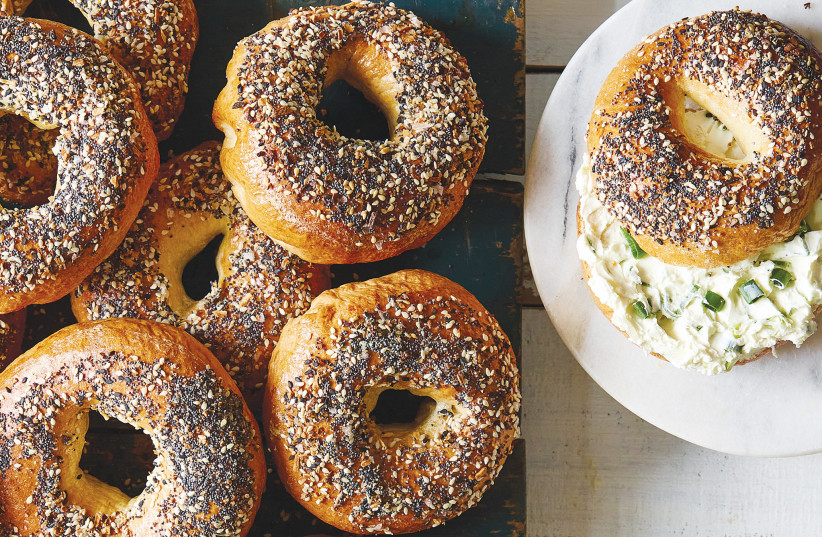Have you ever eaten boiled bread? It doesn’t exactly arouse the appetite, much like tasteless, boiled chicken. How is it, then, that boiled bread has become one of the most iconic breads in the world? I am, of course, referring to bagels!
It is not completely clear when mankind first started boiling bread. The first written reference we have is from 11th-century Jewish commentator Rashi’s description in the Five Books of Moses of the story of the three angels visiting Abraham. It relates there that Sarah prepared copious amounts of bread for the angels (Genesis 18:6). Rashi says that most of the bread was used as a “lid for the pot,” placing loaves on top of the liquid in the pot to soak up the unpalatable broth. If it was unpalatable, then it is unlikely that anyone ate this “boiled” bread.
The first time we have reference in the Bible to boiled bread that was actually eaten is in Moses’ tabernacle. One of the meal offerings was first boiled in water, after which it was baked in the oven and finally fried in oil (Leviticus 6:14). This is probably the original inspiration for the bagel, which emerged many millennia later, as we will soon see.
As for the origin of the bagel’s ring shape, this can be traced back to ancient Egypt, where loaves were baked in ring form so that they could be threaded on a pole and hung high above the floor, away from pesky rodents (re: etchings from the tomb of Kha in Deir el-Medina, 1428-1351 BCE).
Fast forward to ninth-century Prussia. For many centuries, the Christians had been eating ring-shaped Sunday bread (this was before the thin, round wafers of today) as part of their communion ceremony. Part of the reality of persecution of Jews in Europe was that Jews were forbidden to bake any bread resembling Christian breads, especially those used for ritual purposes. If a Jew wanted to bake a similar bread, they had to alter either its appearance or preparation method substantially so that it bore little resemblance to its Christian counterpart.

The Prussian Jewish bakers decided to try something radical. Instead of simply baking the ring-shaped bread, they first boiled it, and then lightly roasted it in the oven. They called this bread a “bagel,” derived from the Yiddish word “beigen,” meaning “to bend.”
The first mention of a bagel in print is from 17th-century Krakow, Poland, where this bread became a Jewish staple. Bagels migrated with Jewish immigrants to the US at the beginning of the 20th century, where they evolved into becoming part of the American culture.
BAGELS ARE chewy partly because of the boiling process but also because of the use of a high-gluten flour, kneaded intensively to make them very elastic. By definition, bagel dough is very stiff and is an infamous “mixer killer” if not kneaded correctly. Hand-kneading bagel dough is very difficult due to its stiffness. Despite the above, it is possible to successfully bake bagels at home, as described in the recipe below.
There is a saying, “If you can’t beat them, join them!” With everyone at boiling point due to the current situation in the country, what better way to spend quality family time together than having a bagel baking session and a delicious bagel meal afterward with cream cheese and lox? ❖
The writer, a master baker originally from Johannesburg, South Africa, lives in Karnei Shomron with his wife, Sheryl, and four children. He is CEO of the Saidel Jewish Baking Center (www.jewishbakingcenter.com) and manages the Showbread Institute (www.showbreadinstitute.org), which researches the biblical showbread.
Garlic Bagels
Makes 12 bagels. If you are not a garlic fan, just leave it out.
- 1 kg. white bread flour (not cake flour)
- 500 ml. lukewarm water
- 1 Tbsp. dry instant yeast
- 1 Tbsp. salt
- 1 Tbsp. sugar
- 1 Tbsp. crystallized garlic powder
Mix water, yeast, salt, sugar, and garlic in the mixer. On low speed, gradually add the flour until one solid lump of dough is formed. Remove the dough from the mixer and divide into four parts. Mix each of the four parts separately (if you mix the entire dough at once, you will damage your mixer’s transmission) for 10 minutes each, on medium to high speed.
Leave the dough to rise for 30 minutes (at 10-minute intervals as they come out of the mixer). Divide each of the four dough parts into three round balls. Lightly flatten each ball with the palm of your hand and punch a hole in the middle of the ball with your thumb. Slowly work the dough around your thumb, widening the hole in the center until you have a bagel shape. Place the bagels on a baking tray lined with silicon or parchment paper and leave to rise for one hour.
Bring a pot of water to the boil and heat the oven to 250 degrees Celsius. Using a slotted spatula, lower the bagels into the boiling water and let them float to the surface for 1 minute.
Remove the bagels with the spatula and place on a second silicon or parchment paper-lined tray. Bake for 20 minutes in the oven. Let cool on wire mesh until still warm – and eat.
Bagels do not remain fresh for long, but they freeze well.
